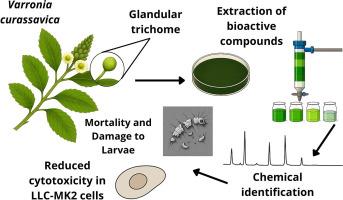Larvicidal efficacy of Varronia curassavica leaf phytochemicals against Aedes aegypti: anatomical, histological and cytotoxic analyses
IF 4
1区 农林科学
Q2 BIOCHEMISTRY & MOLECULAR BIOLOGY
引用次数: 0
Abstract
Aedes aegypti, the primary vector of diseases like Dengue, Zika, Yellow Fever, and Chikungunya, presents a significant public health challenge, particularly in tropical regions. With rising resistance to conventional insecticides, plant-derived bioinsecticides have emerged as a promising alternative. This study assessed the larvicidal potential of phytochemicals from Varronia curassavica, a species native to the Atlantic Forest. Microscopic analyses revealed various trichome types on V. curassavica leaves, including glandular trichomes containing essential oils, phenolic substances, lipids, alkaloids, and pectins and other protein-producing trichomes. Methanolic leaf extracts demonstrated 65 % lethality against third-instar larvae of A. aegypti at 100 ppm. Fractionation of the extract using solvents of increasing polarity identified the dichloromethane (CH₂Cl₂) partition as the most toxic. Further purification of this by silica-gel chromatography produced subfractions, with VCDF11 (Varronia carassavica dichrolometane fraction) showing the highest toxicity (LC50 = 57.0 ppm and LC90 = 74.4 ppm). The VCDF11 fraction was the most active, and subfraction VCDF11.6 exhibited 100 % larvicidal activity. Gas chromatography-mass spectrometry (GC–MS) identified key components, including terpenes (β-copaene, δ-cadinene, phytol) and fatty acids (octadecanol, hexadecanoic acid) in the VCDF11.6 fraction. These compounds disrupted the epidermis, gastric cecum, and larval cuticular layers. An MTT assay confirmed low cytotoxicity of the VCDF11.6 fraction to monkey kidney cells. V. curassavica phytochemicals demonstrate relevant larvicidal activity against A. aegypti larvae with minimal toxicity to mammalian cells, highlighting their potential as a bioinsecticidal agent.

野蔷薇叶植物化学物质对埃及伊蚊的杀幼虫效果:解剖、组织学和细胞毒性分析
埃及伊蚊是登革热、寨卡病毒、黄热病和基孔肯雅热等疾病的主要媒介,对公共卫生构成重大挑战,特别是在热带地区。随着人们对传统杀虫剂的抗性不断增强,植物源性生物杀虫剂已成为一种很有前景的替代品。本研究评估了原产于大西洋森林的木蔷薇(Varronia curassavica)植物化学物质的杀幼虫潜力。显微分析显示,紫花苜蓿叶片上的毛状体有多种类型,包括含有精油、酚类物质、脂类、生物碱、果胶和其他产生蛋白质的毛状体的腺状毛状体。甲醇叶提取物对埃及伊蚊3龄幼虫的致死率为65%,浓度为100ppm。用极性递增的溶剂对萃取物进行分馏,发现二氯甲烷(ch2cl 2)部分毒性最大。通过硅胶层析进一步纯化产生亚组分,VCDF11 (Varronia carassavica二氯甲烷馏分)显示出最高的毒性(LC50 = 57.0 ppm和LC90 = 74.4 ppm)。其中VCDF11活性最强,VCDF11.6活性为100%。气相色谱-质谱联用(GC-MS)鉴定了VCDF11.6馏分中的主要成分,包括萜烯(β-copaene、δ-cadinene、phytol)和脂肪酸(十八烷醇、十六烷酸)。这些化合物破坏表皮、胃盲肠和幼虫角质层。MTT试验证实了VCDF11.6部分对猴肾细胞的低细胞毒性。curassavica植物化学物质对埃及伊蚊幼虫具有一定的杀幼虫活性,对哺乳动物细胞的毒性很小,突出了其作为生物杀虫剂的潜力。
本文章由计算机程序翻译,如有差异,请以英文原文为准。
求助全文
约1分钟内获得全文
求助全文
来源期刊
CiteScore
7.00
自引率
8.50%
发文量
238
审稿时长
4.2 months
期刊介绍:
Pesticide Biochemistry and Physiology publishes original scientific articles pertaining to the mode of action of plant protection agents such as insecticides, fungicides, herbicides, and similar compounds, including nonlethal pest control agents, biosynthesis of pheromones, hormones, and plant resistance agents. Manuscripts may include a biochemical, physiological, or molecular study for an understanding of comparative toxicology or selective toxicity of both target and nontarget organisms. Particular interest will be given to studies on the molecular biology of pest control, toxicology, and pesticide resistance.
Research Areas Emphasized Include the Biochemistry and Physiology of:
• Comparative toxicity
• Mode of action
• Pathophysiology
• Plant growth regulators
• Resistance
• Other effects of pesticides on both parasites and hosts.

 求助内容:
求助内容: 应助结果提醒方式:
应助结果提醒方式:


